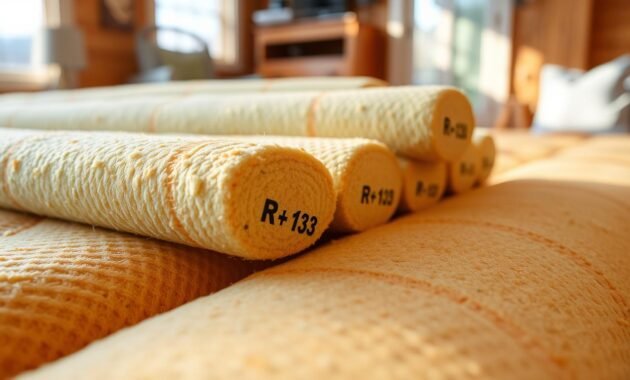As a homeowner, I’m always looking for ways to make my home more energy-efficient and comfortable. R-13 insulation is one material that stands out. It’s made for 2×4 wall cavities and balances cost with performance. But what does R-13 insulation do exactly?
R-13 insulation is used in many ways, both in homes and commercial buildings. It’s great for interior walls, providing top-notch thermal and sound insulation. If you’re building or renovating, R-13 insulation can greatly improve your home’s energy use and comfort.
Read also: Do Interior Walls Need Insulation?
In this article, we’ll explore R-13 insulation in detail. We’ll look at its features, uses, how to install it, and its benefits. By the end, you’ll know why R-13 insulation is a favorite among homeowners and contractors.

Key Takeaways
- R-13 insulation is mainly for interior wall cavities in 2×4 framing
- It offers a balance of thermal performance and cost-effectiveness
- R-13 insulation is easy to install and does not require special equipment
- It can significantly improve energy efficiency and sound attenuation in homes
- R-13 insulation is a popular choice for new construction and renovations
What Is R-13 Insulation?
R-13 insulation is a type of fiberglass batt insulation. It’s known for its high thermal resistance. Homeowners and contractors choose it for its versatility, performance, and affordability.
The “R-13” rating shows its ability to resist heat flow. This makes it a top pick for keeping homes warm in winter and cool in summer.
Overview of R-13 Insulation
Fiberglass R-13 insulation fits snugly between 2×4 wall studs. It comes in various sizes to meet different construction needs. The most common size is 3.5 inches thick, 15 inches wide, and 93 inches long.
This size is ideal for filling 2×4 wall cavities. It offers excellent insulation performance and thermal resistance.
The insulation has a kraft paper, foil-kraft paper, or vinyl facing. This vapor barrier helps control air and moisture. It boosts the insulation’s r-value and effectiveness.
| Insulation Type | R-Value | Thickness | Sizes Available | Batts per Bag |
|---|---|---|---|---|
| Fiberglass Batts | R-13 | 3.5 inches | 3.5 in. x 15 in. x 93 in. 3.5 in. x 24 in. x 96 in. | 11 or 12 |
R-13 insulation has a high r-value. This makes it great for boosting your home’s energy efficiency. It reduces heat transfer through walls.
This can lower your heating and cooling costs. It also improves comfort and indoor air quality.
How R-13 Insulation Works
The R-value is key in home insulation, showing how well a material stops heat flow. R-13 insulation is a top pick for its good thermal performance and value. It’s great for keeping your home comfy and saving on energy.
Understanding R-Value
The R-value shows how well insulation blocks heat. The higher the R-value, the better it keeps heat out. R-13 insulation traps air, slowing heat through walls, floors, and ceilings.
This makes your home more comfortable and energy-efficient.
Read also: Cheap Way to Insulate Block Walls in Your Home
Thermal Resistance Explained
R-13 insulation fights both solid and air heat transfer. It traps air, slowing heat flow. This boosts thermal resistance and cuts energy costs for heating and cooling.
| Insulation Type | R-Value per Inch | Thickness for R-13 | Thickness for R-15 |
|---|---|---|---|
| Thermasheath | ~3.8 | 2 inches | 2.3 inches |
| Durasheath | ~3.6 | 2.2 inches | 2.5 inches |
Getting R-13 insulation right is all about proper installation. Gaps or compression can lower its effectiveness. Knowing about heat transfer and R-value helps choose the best insulation.

Common Uses for R-13 Insulation
R-13 insulation is used in many ways in homes. It’s found in walls, floors, ceilings, and attics. It’s known for its good balance of keeping warm and being affordable.
Interior Wall Insulation
R-13 insulation is often used in walls, like those in 2×4 frames. It’s great for keeping sound out and warmth in. It’s a favorite for building new homes and fixing up old ones.
Floor and Ceiling Insulation
R-13 insulation works well in tight spaces like floors and ceilings. In attics, it’s a starting point. More insulation can be added to get even better results.
Attic Insulation Applications
Attics are another place where R-13 insulation is used. It helps keep the house warm and saves on energy bills. Adding more insulation to it makes it even better.
R-13 insulation is a smart choice for many home needs. It’s affordable and effective, making homes warmer and quieter.
Installation of R-13 Insulation
Getting your R-13 insulation installed right is key. Whether you’re doing it yourself or hiring a pro, knowing the tools and steps is important. It helps you get the most energy savings and air sealing for your building.
Tools Needed for Installation
You’ll need a measuring tape, insulation knife, stapler, and safety gear like gloves and goggles. These tools help you measure, cut, and secure the insulation. This ensures a good fit and top insulation performance.
Step-by-Step Installation Guide
- Measure the space: Measure the area’s length, width, and depth. This ensures the insulation fits perfectly.
- Cut the insulation: Use the knife to cut the R-13 batts or rolls to size. Make them a bit bigger to ensure a tight seal.
- Install the insulation: Place the insulation in the cavity carefully. Make sure it touches all sides and isn’t compressed or wrinkled.
- Secure the insulation: Use a stapler to fasten the insulation, focusing on edges and seams. This prevents gaps and air leaks.
Read also: How to Cut Roll Insulation Accurately
Common Installation Mistakes
- Compressing the insulation: Don’t compress the R-13 insulation. It reduces its effectiveness.
- Leaving gaps: Cut the insulation to fit perfectly and seal any gaps or cracks around the edges.
- Failing to address air leaks: Before installing insulation, seal air leaks around doors, windows, and outlets. This boosts insulation performance.
By avoiding these mistakes and following best practices, your R-13 insulation will work as expected. It will save energy and make your space more comfortable.
Benefits of R-13 Insulation
R-13 insulation is a smart choice for your home. It’s affordable and helps save money. It also reduces noise and fights moisture and mold. These benefits make your home more energy efficient and comfortable.
Cost-Effectiveness and Savings
R-13 insulation is a budget-friendly option. It’s cheaper than some other insulation but works well. It saves you money on heating and cooling costs over time.
Sound Dampening Benefits
R-13 insulation is great at blocking noise. It can cut down sound levels by up to 90%. This makes your home quieter and more peaceful.
Moisture and Mold Resistance
Some R-13 insulation, like wool, fights moisture well. It helps prevent mold and keeps your home healthy. This makes the insulation last longer.
Choosing R-13 insulation boosts your home’s energy efficiency, noise reduction, and thermal performance. It’s a smart pick for better home comfort and efficiency.
Comparing R-13 to Other Insulation Types
The R-value is key when picking insulation. R-13 is a popular choice, balancing cost and performance well. But, it’s good to know how it stacks up against R-15, foam, and cellulose.
R-13 vs. R-15 Insulation
R-13 is often used in 2×4 walls, giving good thermal resistance. R-15, with its higher R-value, is a denser option. Your choice between R-13 and R-15 depends on your needs, budget, and project specifics.
R-13 vs. Foam and Cellulose
R-13 fiberglass is cheaper and easier to put in than foam. But, foam can pack more R-value per inch, making it more efficient in some cases. Cellulose, from recycled paper, has similar R-values to fiberglass but might seal air better.
Every insulation type has its own strengths and fits different projects and budgets. When picking insulation, think about its thermal performance, cost, and how hard it is to install. This ensures you get the most value for your money.
| Insulation Type | R-Value per Inch | Advantages | Disadvantages |
|---|---|---|---|
| R-13 Fiberglass | R2 – R3 | Affordable, easy to install | Lower R-value per inch compared to foam |
| R-15 Fiberglass | R2 – R3 | Slightly higher thermal performance than R-13 | More expensive than R-13 |
| Foam Insulation | R3 – R7 | High R-value per inch, superior air sealing | More expensive, can be more difficult to install |
| Cellulose Insulation | R3 – R4 | Excellent air sealing, made from recycled materials | Can be more expensive than fiberglass, may settle over time |

Building Code Compliance and R-13
Insulation is key in meeting building codes and energy standards. Codes set R-values for insulation based on climate and building part. R-13 insulation often meets code for wood-framed walls in many zones, with exterior insulation.
Code Requirements for Insulation
Insulation R-values vary by climate and building part. In cold climates, higher R-values are needed. Always check local codes and regulations for the right insulation.
How R-13 Meets Code Standards
R-13 insulation helps meet energy needs in many homes. But, the wall’s R-value depends on more than just insulation. Thermal bridges, framing, and exterior insulation affect performance. Knowing these factors ensures R-13 meets code standards.
| Climate Zone | U-Factor Requirement | Suggested Solutions |
|---|---|---|
| Climate Zone 5 | 0.052 | Insulated metal panels, single or double-layer fiberglass filled cavity systems |
The U-factor method is an alternative for meeting thermal performance. It offers flexibility in code compliance. Understanding R-13’s performance helps meet energy standards.
Conclusion
Why Choose R-13 Insulation?
R-13 insulation is a smart choice for many reasons. It’s affordable and easy to install. It also helps with sound and keeps your home warm.
Even though it’s not the highest rated, its price and availability make it popular. It meets building codes in many places. This makes it great for improving your home’s energy use and comfort.
Final Thoughts on Its Applications
Choosing R-13 insulation depends on your project’s needs and local climate. Make sure it fits your building code requirements. This way, you get the best energy savings and comfort.
R-13 insulation is known for being reliable and practical. It’s a top pick for many homes and small businesses. It’s all about finding the right insulation for your project.
So, whether you pick R-13 or something else, think about what you need. R-13 is a solid choice for those looking to save energy and make their homes more comfortable.


